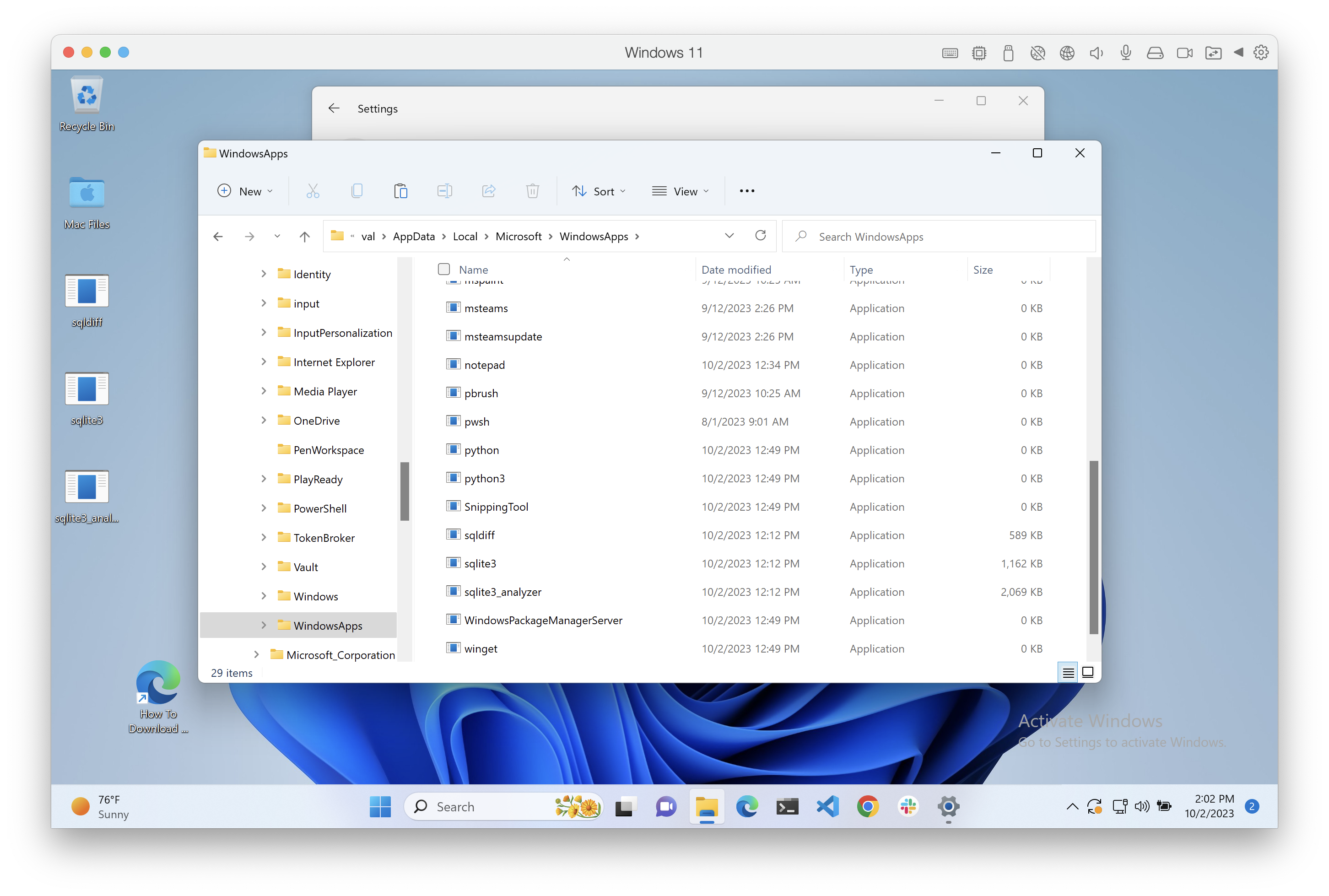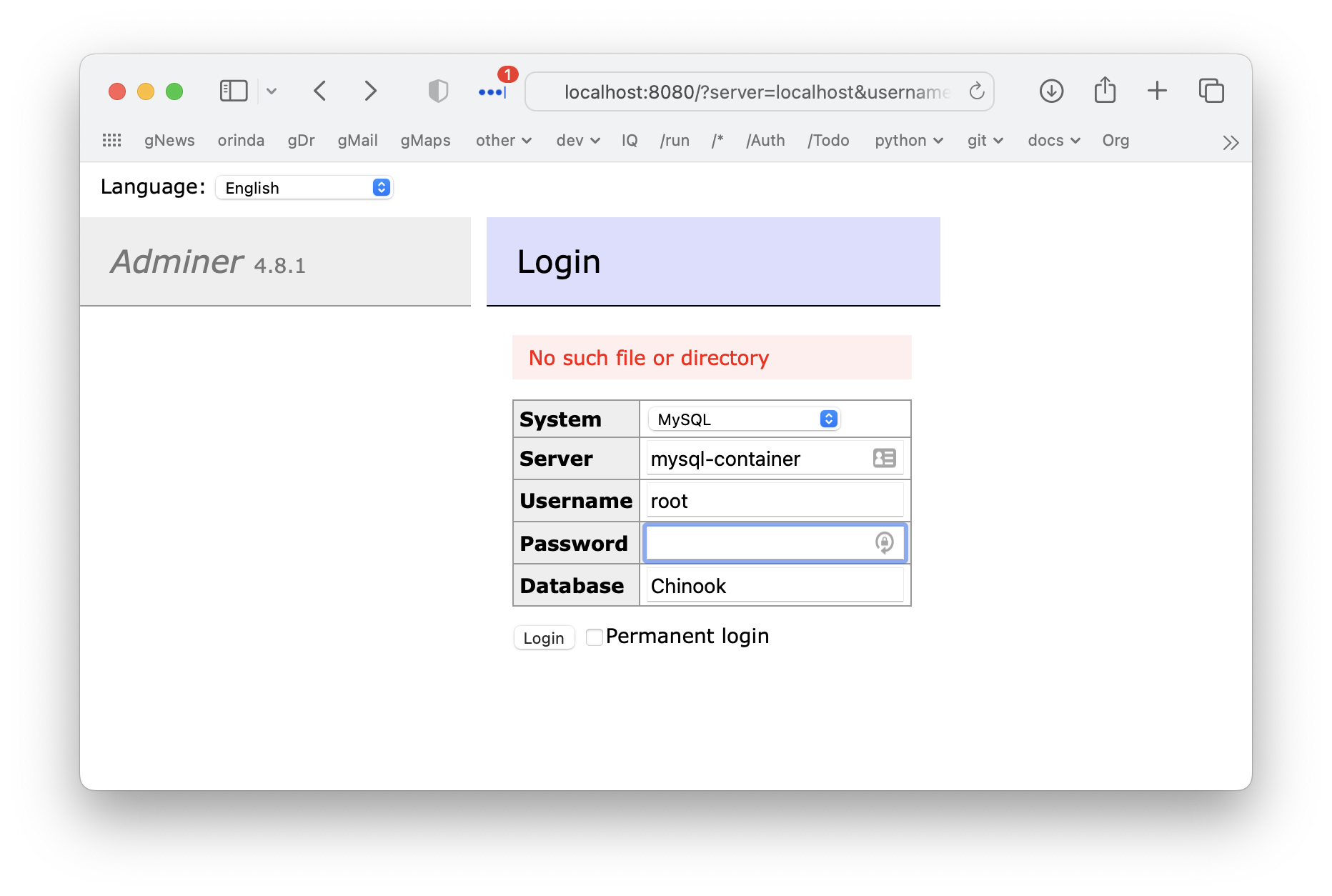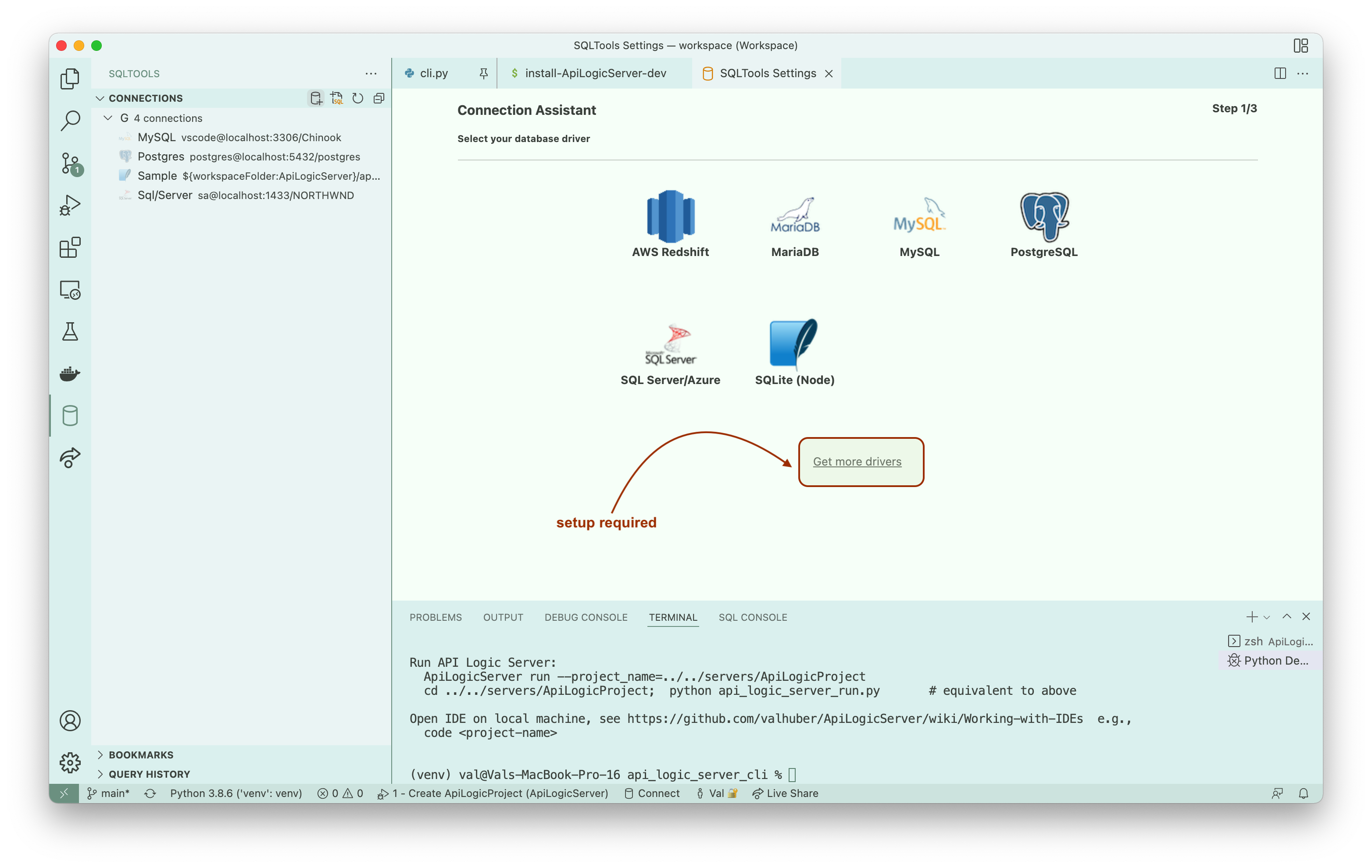Connection Examples, Debug

You create API Logic Projects with the CLI, providing the db_url parameter -- a SQLAlchemy URI.
-
See below for several examples
-
Or use the abbrevations to explore pre-supplied test databases - see here.
This page provides background on connecting, including database tools and debugging connections.
Examples
Recall the db_url parameter is a SQLAlchemy URI. To see some examples, see below, and use
ApiLogicServer examples
This produces a console log like:
ApiLogicServer create
ApiLogicServer create-and-run
ApiLogicServer create --db_url=sqlite:////Users/val/dev/todo_example/todos.db --project_name=todo
ApiLogicServer create --db_url=sqlite:///c:\ApiLogicServer\nw.sqlite --project_name=nw
ApiLogicServer create --db_url=sqlite:///ai.sqlite --project_name=ai --open_with=code
ApiLogicServer create --db_url=mysql+pymysql://root:p@mysql-container:3306/classicmodels --project_name=/localhost/docker_db_project
ApiLogicServer create --db_url='mssql+pyodbc://sa:Posey3861@localhost:1433/NORTHWND?driver=ODBC+Driver+18+for+SQL+Server&trusted_connection=no&Encrypt=no'
ApiLogicServer create --project_name=oracle_hr --db_url='oracle+oracledb://hr:tiger@localhost:1521/?service_name=ORCL'
ApiLogicServer create --db_url=postgresql://postgres:p@10.0.0.234/postgres
ApiLogicServer create --project_name=my_schema --db_url=postgresql://postgres:p@localhost/my_schema
ApiLogicServer create --db_url=postgresql+psycopg2://postgres:password@localhost:5432/postgres?options=-csearch_path%3Dmy_db_schema
ApiLogicServer create --project_name=Chinook \
--host=ApiLogicServer.pythonanywhere.com --port= \
--db_url=mysql+pymysql://ApiLogicServer:@ApiLogicServer.mysql.pythonanywhere-services.com/ApiLogicServer\$Chinook
Where --db_url is one of...
<default> Sample DB - https://apilogicserver.github.io/Docs/Sample-Database/
<db_url abbreviation> Other Samples - https://apilogicserver.github.io/Docs/Data-Model-Examples/
<SQLAlchemy Database URI> Your own database - https://docs.sqlalchemy.org/en/14/core/engines.html
Other URI examples: - https://apilogicserver.github.io/Docs/Database-Connectivity//
Docs: https://apilogicserver.github.io/Docs/
Important notes:
- tables without primary keys are not imported as classes, and do not appear in your API or Admin application
Verify Database Connectivity
Database connectivity can be... trying. Before attempting the SQLAlchemy connectivity discussed here, it's a best practice to make sure your computer can connec to the database server. One possible approach is a command line utility called telnet.
First, ensure your machine has telnet installed. Consult the documentation for your OS type. Note that Windows 11 requires this command (use Powershell, and run as adminstrator):
Enable-WindowsOptionalFeature -Online -FeatureName TelnetClient
Then, you can issue a command such as:
telnet 10.0.0.77 3306 # where you subsitute IP address)
Explore SQLAlchemy
To facilitate exploring SQLAlchemy, each project contains a database/db_debug/db_debug.py.
Alter it to explore SQLAlchemy features and IDE support, as illustrated in the sample project.
Oracle debug
For Oracle connections, ApiLogicServer create creates database/db_debug/sa-pydb.py. You can use this to explore Oracle connections.
Sqlite
You can use an existing sqlite database like this:
ApiLogicServer create --project_name=Allocation --db_url=sqlite:////Users/val/Desktop/database.sqlite
Other important notes:
- As shown above, use the full path
- So that such databases are included in your project, they are copied to the
databasefolder, and renamed todb.sqlite' - The project URL in
conf/config.pyis made relative to this location (sqlite:///../database/db.sqlite). This keeps your projects portable, e.g., colleagues can pull your project fromGitHuband run.
CLI Installation
The sqlite runtime is installed with API Logic Server. You might, however, wish to install the command line tools (CLI).
These are typically already installed on Mac computers.
For windows, download and unzip this file:

And copy the 3 exe files to a place where they can be run, such as ~/AppData/Local/Microsoft/WindowsApps:

Northwind - sqlite (default sample)
See Sample Database.
This is a sqlite database, packaged with API Logic Server, so you can explore without any installs. It is obtained from Northwind, and altered to include several columns to demonstrate rules.
Run under API Logic Server docker:
ApiLogicServer run --project_name=/localhost/docker_project
Chinook - Albums and Artists
Designate this as follows: --db_url={install}/Chinook_Sqlite.sqlite, e.g.:
~/ApiLogicServer/api_logic_server_cli/database/Chinook_Sqlite.sqlite
SQLite Database Abbreviations
To make experimenting easier, you can specify a db_url shortcut.
Docker Databases
Managing Database in your IDE
Various IDEs provide tools for managing databases.
dbvis
dbvis is a very popular tool, with support for exporting tables and data.
For local connections, consider resetting trustServerCertificate:

adminer
You can find it here.
Try:
docker run --name adminer --link some_database:db -p 8080:8080 --net dev-network adminer
Then you can hit http://localhost:8080 or http://host-ip:8080 in your browser:

You will need to install plug-ins for sqlite3, to address logging in without a password
PyCharm Database Tools
Pycharm provides excellent database tools, as shown below:

VSCode Database Tools
I also use SQLTools. To use it, you must first install drivers:

You may want to install extensions for MySQL and Postgres.
Then, you can explore the sample:

Docker pgadmin
See discussion above.
Azure Data Studio
See discussion above.
PythonAnywhere
PythonAnyWhere provides the ability to create and connect to databases. For example, create a project like this from within PythonAnyWhere:
ApiLogicServer create --project_name=Chinook \
--host=ApiLogicServer.pythonanywhere.com --port= \
--db_url=mysql+pymysql://ApiLogicServer:Your-DB-Password@ApiLogicServer.mysql.pythonanywhere-services.com/ApiLogicServer\$Chinook
Notes:
- Be aware of connectivity and firewall issues.